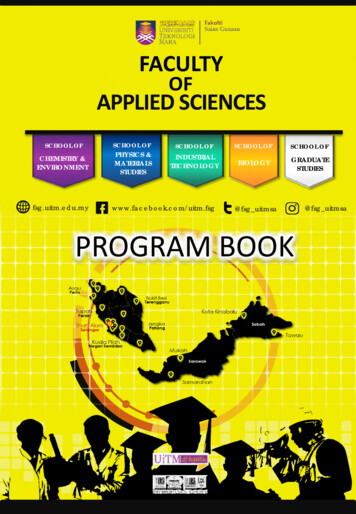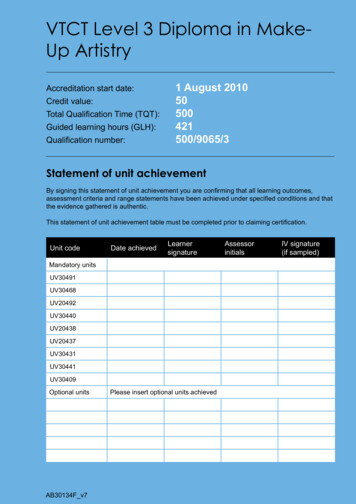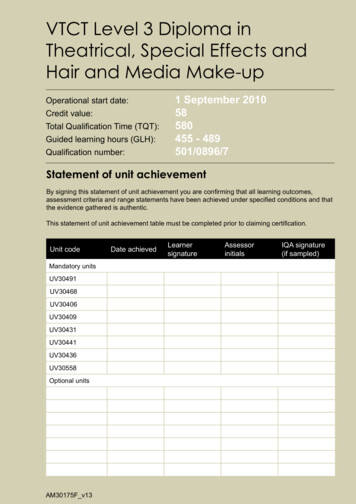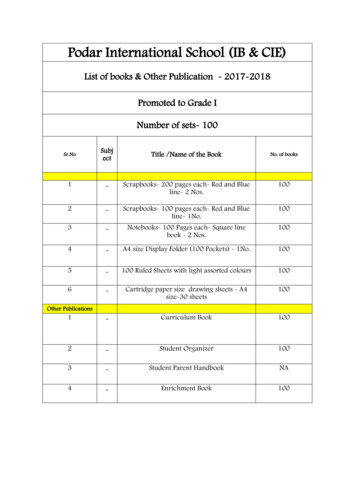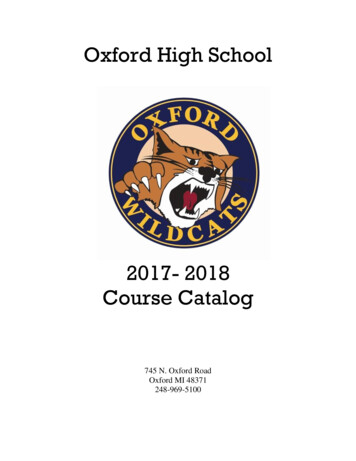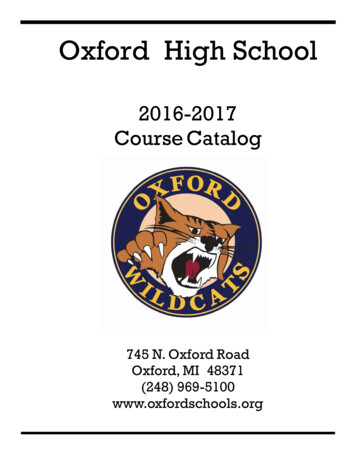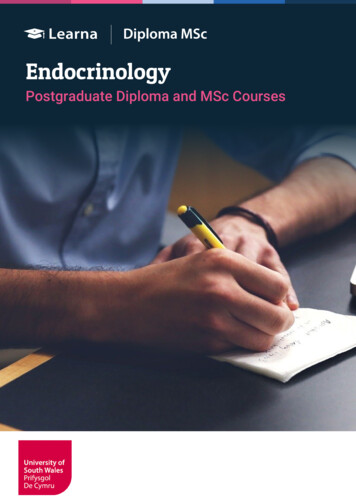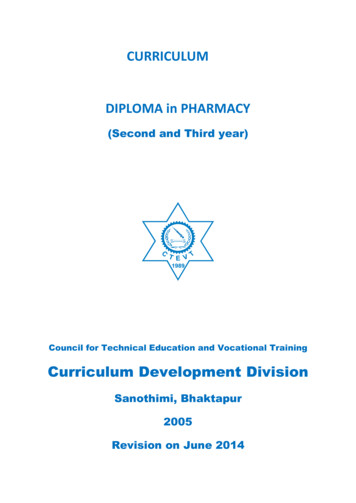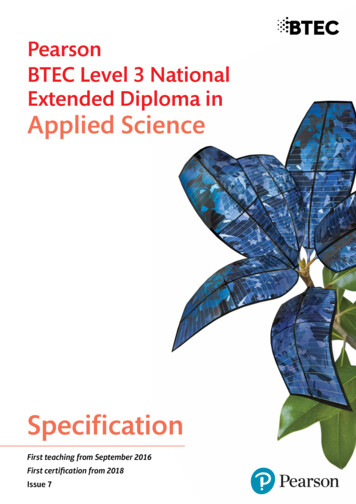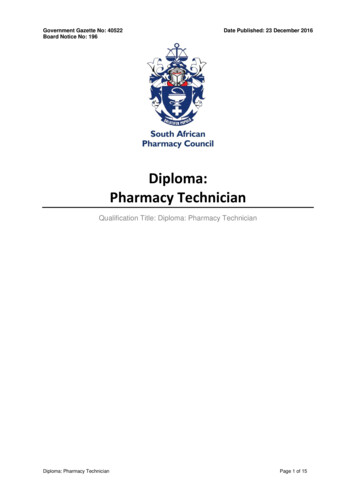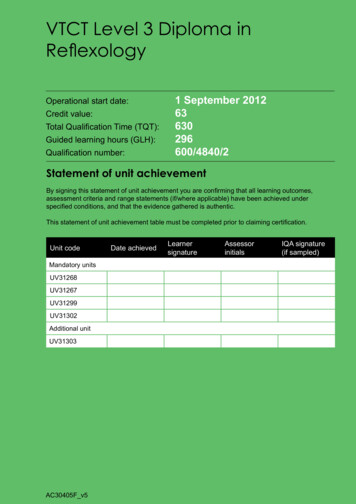
Transcription
VTCT Level 3 Diploma inReflexology1 September 2012Credit value: 63Total Qualification Time (TQT):630Guided learning hours (GLH):296Qualification number: 600/4840/2Operational start date:Statement of unit achievementBy signing this statement of unit achievement you are confirming that all learning outcomes,assessment criteria and range statements (if/where applicable) have been achieved underspecified conditions, and that the evidence gathered is authentic.This statement of unit achievement table must be completed prior to claiming certification.Unit codeMandatory unitsUV31268UV31267UV31299UV31302Additional unitUV31303AC30405F v5Date achievedLearnersignatureAssessorinitialsIQA signature(if sampled)
The qualificationIntroductionThe VTCT Level 3 Diploma in Reflexology isa preparation for work qualification that hasbeen designed to prepare you for a career as areflexologist.This qualification will develop your knowledgeand understanding of the principles and practiceand business practice for complementarytherapies. Furthermore, you will learn aboutanatomy, physiology and pathology forcomplementary therapies.You will also develop your understandingand practical skills to competently providereflexology services. You may also choose tocomplete an additional unit which will developyour knowledge and understanding of healthyeating and wellbeing for the complementarytherapy client.This is a practitioner level qualification.2National Occupational Standards (NOS)This qualification has been mapped tothe relevant NOS, and is regulated on theRegulated Qualifications Framework (RQF).This qualification is approved and supportedby Skills for Health, the sector skills council forhealth.PrerequisitesLearners who wish to undertake thisqualification must also achieve the VTCT(ITEC) Level 2 Award in Infection Prevention(COVID-19) for Complementary Therapies andSports Massage qualification or a regulatedequivalent.Your centre will have ensured that you havethe required knowledge, understanding andskills to enrol and successfully achieve thisqualification.
ProgressionOn completion of this qualification you maychoose to undertake further study; qualificationsyou could progress to include: VTCT Level 3 Diploma in ComplementaryTherapies VTCT Level 3 Diploma in Aromatherapy VTCT Level 3 Diploma in Massage VTCT Level 3 Certificate in Anatomy,Physiology and Pathology forComplementary TherapiesProgression opportunities are also available tospecialist complementary therapy qualificationsat Level 4.Alternatively, you may wish to seek employmentor self-employment as a: Complementary therapist Reflexologist3
Qualification structureTotal credits required - 63All mandatory units must be completed.Mandatory units -63 creditsVTCT unitcodeOfqual unitreferenceUnit titleUV31268A/503/7776UV31267Credit valueGLHPrinciples and practice of complementarytherapies1330L/503/7779Business practice for ge of anatomy, physiology andpathology for complementary therapies1394UV31302K/503/7725Provide reflexology for complementarytherapies25112Credit valueGLH630Additional unit*VTCT unitcodeOfqual unitreferenceUnit titleUV31303J/503/7747Healthy eating and wellbeing for thecomplementary therapy client*Does not contribute to the overall credit of this qualification.4
Guidance on assessmentThis book contains the mandatory units that make up this qualification. Optional units will beprovided in additional booklets (if applicable). Where indicated, VTCT will provide assessmentmaterials. Assessments may be internal or external. The method of assessment is indicated ineach unit.Internal assessment(any requirements will be shown in the unit)Assessment is set, marked and internallyquality assured by the centre to clearlydemonstrate achievement of the learningoutcomes. Assessment is sampled by VTCTexternal quality assurers.External assessment(any requirements will be shown in the unit)Externally assessed question paperscompleted electronically will be set and markedby VTCT.Externally assessed hard-copy question paperswill be set by VTCT, marked by centre staff andsampled by VTCT external quality assurers.Assessment explainedVTCT qualifications are assessed and verifiedby centre staff. Work will be set to improve yourpractical skills, knowledge and understanding.For practical elements, you will be observedby your assessor. All your work must becollected in a portfolio of evidence and crossreferenced to requirements listed in this recordof assessment book.Your centre will have an internal quality assurerwhose role is to check that your assessmentand evidence is valid and reliable and meetsVTCT and regulatory requirements.An external quality assurer, appointed byVTCT, will visit your centre to sample andquality-check assessments, the internal qualityassurance process and the evidence gathered.You may be asked to attend on a different dayfrom usual if requested by the external qualityassurerThis record of assessment book is yourproperty and must be in your possession whenyou are being assessed or quality assured. Itmust be kept safe. In some cases your centrewill be required to keep it in a secure place.You and your course assessor will togethercomplete this book to show achievement of alllearning outcomes, assessment criteria andranges.5
Creating a portfolio of evidenceAs part of this qualification you are required toproduce a portfolio of evidence. A portfolio willconfirm the knowledge, understanding and skillsthat you have learnt. It may be in electronic orpaper format.Your assessor will provide guidance on how toprepare the portfolio of evidence and how toshow practical achievement and understandingof the knowledge required to successfullycomplete this qualification. It is this bookletalong with the portfolio of evidence that willserve as the prime source of evidence for thisqualification.Evidence in the portfolio may take the followingforms: Observed workWitness statementsAudio-visual mediaEvidence of prior learning or attainmentWritten questionsOral questionsAssignmentsCase studiesAll evidence should be documented in theportfolio and cross-referenced to unit outcomes.Constructing the portfolio of evidence should notbe left to the end of the course.6Case studiesTo achieve this qualification you must carry outand document evidence of the following casestudies:UV31302 - Provide reflexology forcomplementary therapies: You must carryout and document evidence for at least 100treatments.
Unit assessment methodsThis section provides an overview of the assessment methods that make up each unit in thisqualification. Detailed information on assessment is provided in each unit.Mandatory unitsExternalVTCT unitcodeUnit Portfolio ofEvidencePrinciples and practice ofcomplementary therapies0û UV31267Business practice forcomplementary therapies0û UV31299Knowledge of anatomy, physiologyand pathology for complementarytherapies2û UV31302Provide reflexology forcomplementary therapies0 Additional unitExternalVTCT unitcodeUnit titleUV31303Healthy eating and wellbeing forthe complementary therapy lio ofEvidence0û 7
Unit glossaryDescription8VTCT productcodeAll units are allocated a unique VTCT product code for identification purposes.This code should be quoted in all queries and correspondence to VTCT.Unit titleThe title clearly indicates the focus of the unit.NationalOccupationalStandards(NOS)NOS describe the skills, knowledge and understanding needed to undertake aparticular task or job to a nationally recognised level of competence.LevelLevel is an indication of the demand of the learning experience; the depthand/or complexity of achievement and independence in achieving thelearning outcomes.Credit valueThis is the number of credits awarded upon successful achievement of all unitoutcomes. Credit is a numerical value that represents a means of recognising,measuring, valuing and comparing achievement.Guidedlearning hours(GLH)The activity of a learner in being taught or instructed by - or otherwiseparticipating in education or training under the immediate guidance or supervisionof - a lecturer, supervisor, tutor or other appropriate provider of education ortraining.Totalqualificationtime (TQT)The number of hours an awarding organisation has assigned to a qualification forGuided Learning and an estimate of the number of hours a learner will reasonably belikely to spend in preparation, study, or any other form of participation in education ortraining. This includes assessment, which takes place as directed - but, unilke GuidedLearning, not under the immediate guidance or supervision of - a lecturer, supervisor,tutor or other appropriate provider of education or training.ObservationsThis indicates the minimum number of competent observations, per outcome,required to achieve the unit.LearningoutcomesThe learning outcomes are the most important component of the unit; they setout what is expected in terms of knowing, understanding and practicalability as a result of the learning process. Learning outcomes are the resultsof learning.EvidencerequirementsThis section provides guidelines on how evidence must be gathered.ObservationoutcomeAn observation outcome details the tasks that must be practicallydemonstrated to achieve the unit.KnowledgeoutcomeA knowledge outcome details the theoretical requirements of a unit that mustbe evidenced through oral questioning, a mandatory written question paper, aportfolio of evidence or other forms of evidence.AssessmentcriteriaAssessment criteria set out what is required, in terms of achievement, to meeta learning outcome. The assessment criteria and learning outcomes are thecomponents that inform the learning and assessment that should take place.Assessment criteria define the standard expected to meet learning outcomes.RangeThe range indicates what must be covered. Ranges must be practicallydemonstrated in parallel with the unit’s observation outcomes.
UV31268Principles and practice ofcomplementary therapiesThe aim of this unit is to develop your knowledge andunderstanding of the history and influences on thecomplementary therapy sector.UV31268 v10
Level3Credit value13GLH30Observation(s)0External paper(s)0
Principles and practice ofcomplementary therapiesLearning outcomesOn completion of this unit you will:1.Understand the key historical factors andtheoretical background for complementarytherapies2.Understand the main influences on workingwithin the complementary therapy industry3.Understand the key aspects of good clinicalpracticeEvidence requirements1.Knowledge outcomesThere must be evidence that you possessall the knowledge and understandinglisted in the Knowledge section of thisunit. In most cases this can be doneby professional discussion and/or oralquestioning. Other methods, such asprojects, assignments and/or reflectiveaccounts may also be used.2.Tutor/Assessor guidanceYou will be guided by your tutor/assessoron how to achieve learning outcomes in thisunit. All outcomes must be achieved.3.External paperThere is no external paper requirement forthis unit.UV3126811
Developing knowledgeAchieving knowledge outcomesYou will be guided by your tutor and assessoron the evidence that needs to be produced.Your knowledge and understanding will beassessed using the assessment methods listedbelow*: ProjectsObserved workWitness statementsAudio-visual mediaEvidence of prior learning or attainmentWritten questionsOral questionsAssignmentsCase studiesProfessional discussion*This is not an exhaustive list.12UV31268When a criterion has been orally questionedand achieved, your assessor will record thisevidence in written form or by other appropriatemeans.
KnowledgeLearning outcome 1Understand the key historical factors and theoreticalbackground for complementary therapiesYou can:a.Examine the history and origins of complementary therapiesb.Identify commonly available complementary therapiesc.Evaluate the theory of techniques used in commonly availablecomplementary therapiesPortfolio reference /Assessor initials** Assessor initials to be inserted if orally questioned.UV3126813
Learning outcome 2Understand the main influences on working within thecomplementary therapy industryYou can:a.Summarise the legal obligations of working with clients and thegeneral publicb.Explain the codes of practice and ethics relating to complementarytherapiesc.Analyse the roles of professional organisations relating tocomplementary therapiesd.Evaluate the process of registration and regulation ofcomplementary therapies* Assessor initials to be inserted if orally questioned.14UV31268Portfolio reference /Assessor initials*
Learning outcome 3Understand the key aspects of good clinical practiceYou can:a.Identify the information required for assessment and treatmentplanningb.Explain how to accurately record information, store records andensure confidentialityc.Evaluate appropriate referral procedures and protocols to use withclients and others involved in integrated healthcared.Identify effective communication skills when dealing with clientsand colleagues in maintaining good practicePortfolio reference /Assessor initials** Assessor initials to be inserted if orally questioned.UV3126815
Unit contentThis section provides guidance on the recommended knowledge and skills required to enable youto achieve each of the learning outcomes in this unit. Your tutor/assessor will ensure you have theopportunity to cover all of the unit content.Learning outcome 1: Understand the key historical factors and theoreticalbackground for complementary therapiesHistory and origins: Body massage,aromatherapy, reflexology, history anddevelopment from ancient times to modernday (e.g. Ancient Egypt, China, India,Ancient Greece, Rome, Persia, Europe andthe Americas), the history and developmentof other therapies (e.g. acupuncture,Alexander technique, aromatherapy, Bachflower, Bowen technique, shiatsu, Reiki,remedial massage, kinesiology, herbalism,hypnotherapy).Definitions and theories: Massage(Swedish massage movements, physicaleffects and benefits, psychological effects),definitions and theories of aromatherapy(the uses of essential oils, physicaleffects and benefits, psychologicaleffects), definitions and theories ofreflexology (reflex points, zones and theirrelationship to body systems, physicaleffects and benefits, psychologicaleffects), concept of holism, holistic health,concept of balance and harmony, effectsof physical environment on health andwellbeing, effects of social, economicand environmental factors on health andwellbeing.Theory of techniques: Body massage,aromatherapy, reflexology, other therapies(e.g. acupuncture, Alexander technique,aromatherapy, flower essences, Bowentechnique, shiatsu, Reiki, remedialmassage, kinesiology, herbalism,hypnotherapy), the value of differenttheories.16UV31268
Learning outcome 2: Understand the main influences on working within thecomplementary therapy industryLegislative requirements and workingpractice: Applicable national/locallegislation relating to the workplace (e.g.health and safety, equality and diversity,data protection, employment, consumerprotection, workplace regulations, manualhandling, use of work equipment, liabilityinsurance, employees, professionalindemnity, control of substanceshazardous to health, handling/storage/disposal/cautions of use of products, fireprecautions, hygiene practice, disposal ofwaste, environmental protection), furtherinformation should be sought from therelevant authorities.Legal obligations: Working with clientsand the general public, duty of care,disclosure, insurance (e.g. employers’liability, personal accident), confidentiality,importance of meeting legal obligations toclients.Codes of practice and ethics: Definitionof codes of practice, definition of ethics,importance of codes of practice and ethics,codes of practice and ethics developed bythe industry and professional associations(e.g. FHT - www.fht.org.uk).Roles of professional associations andorganisations: For example, Federation ofHolistic Therapists (FHT), aims/objectives/roles/activities/functions of professionalassociations. For more details see NationalOccupational Standards (Skills for Health).Process of registration and regulation:Statutory regulation of the profession (e.g.Criminal Records Bureau (CRB)), voluntaryregulation (Complementary and NaturalHealthcare Council (CNHC)).UV3126817
Learning outcome 3: Understand the key aspects of good clinical practiceInformation for assessment andtreatment planning: Consultation (clientpositioning to minimise barriers, privacyand comfort, verbal and non-verbalcommunication, medical history, lifestylequestionnaire, client expectations andpreparation), review of assessment to plantreatment programme, agree treatmentwith client, obtain written consent, preparea treatment record sheet, refer the client ifnecessary whilst ensuring confidentiality,adhering to data protection.Record keeping and confidentiality:Methods of recording and storinginformation (e.g. written, computerdatabase), importance of accurate recordkeeping whilst ensuring confidentiality,adherence to legislation (e.g. dataprotection), following professional codes ofconduct, disclosure of information to others(e.g. non-disclosure, referral).Referral procedures and protocols:Working within the limits of ownresponsibility and qualifications, importanceof recommending appropriate treatmentsfor client’s condition, methods of referral,when to refer, to whom to refer (e.g. GP,counsellor, other complementary therapist,member of the social care or nursing team,Social Services, Citizens Advice Bureau).Communication skills: Verbal(language, tone of voice, clarity, useof open and closed questioning), nonverbal (active listening techniques, bodylanguage, gestures, eye contact, facialexpressions), use of visual aids, barriersto effective communication, importanceof communication and rapport with others(clients, working team, other therapists,suppliers).18UV31268
UV31267Business practice forcomplementary therapiesThe aim of this unit is to develop your knowledge,understanding and practical skills in researching,planning, maintaining and marketing a business in thecomplementary therapy industry. You will also learn tocommunicate effectively with clients and colleagues.UV31267 v10
Level3Credit value12GLH60Observation(s)0External paper(s)0
Business practice forcomplementary therapiesLearning outcomesOn completion of this unit you will:1.Understand the key business criteriarequired for complementary therapies2.Be able to research a business concept3.Be able to prepare a business planEvidence requirements1.Knowledge outcomesThere must be evidence that you possessall the knowledge and understandinglisted in the Knowledge section of thisunit. In most cases this can be doneby professional discussion and/or oralquestioning. Other methods, such asprojects, assignments and/or reflectiveaccounts may also be used.2.Tutor/Assessor guidanceYou will be guided by your tutor/assessoron how to achieve learning outcomes in thisunit. All outcomes must be achieved.3.External paperThere is no external paper requirement forthis unit.UV3126721
Developing knowledgeAchieving knowledge outcomesYou will be guided by your tutor and assessoron the evidence that needs to be produced.Your knowledge and understanding will beassessed using the assessment methods listedbelow*: ProjectsObserved workWitness statementsAudio-visual mediaEvidence of prior learning or attainmentWritten questionsOral questionsAssignmentsCase studiesProfessional discussion*This is not an exhaustive list.22UV31267When a criterion has been orally questionedand achieved, your assessor will record thisevidence in written form or by other appropriatemeans.
KnowledgeLearning outcome 1Understand the key business criteria required forcomplementary therapiesYou can:a.Explain the legal requirements for running a businessb.Explain how marketing and public relations are used in businessesc.Describe the employment opportunities within the complementarytherapy industryd.Explain how to promote complementary therapy practicesPortfolio reference /Assessor initials** Assessor initials to be inserted if orally questioned.UV3126723
Learning outcome 2Be able to research a business conceptYou can:a.Compare and contrast different business typesb.Research a potential business opportunity using a range ofresourcesc.Research potential premises, staff, products and resourcerequirements* Assessor initials to be inserted if orally questioned.24UV31267Portfolio reference /Assessor initials*
Learning outcome 3Be able to prepare a business planYou can:a.Prepare a business plan for self-employmentb.Describe the professional services, staff and resources that maybe required for a business planPortfolio reference /Assessor initials** Assessor initials to be inserted if orally questioned.UV3126725
Unit contentThis section provides guidance on the recommended knowledge and skills required to enable youto achieve each of the learning outcomes in this unit. Your tutor/assessor will ensure you have theopportunity to cover all of the unit content.Learning outcome 1: Understand the key business criteria required forcomplementary therapiesLegal requirements: Applicable national/local legislation relating to the workplace(e.g. health and safety, equality anddiversity, data protection, employment,consumer protection, workplaceregulations, manual handling, use ofwork equipment, liability insurance,employees, professional indemnity,control of substances hazardous to health,handling/storage/disposal/cautions ofuse of products, fire precautions, hygienepractice, disposal of waste, environmentalprotection), further information should besought from the relevant authorities.Marketing and public relations:Importance of marketing and publicrelations, market research andsegmentation, customer needs and wants,promotion of products and services.Employment opportunities: Selfemployed (renting a room, room in ownhome, mobile therapist, owning a clinic),employed (spa, salon, clinic, healthcare,hotels, fitness centres, cruises, education,agency), full-time and part-time, careerprogressions (e.g. junior therapist,therapist, senior therapist, manager),roles and responsibilities, advantages anddisadvantages of different employmentopportunities (e.g. location, pay, conditions,progression routes, development).Communication techniques: Verbal(language, tone of voice, clarity, useof open and closed questioning), nonverbal (active listening techniques, bodylanguage, gestures, eye contact, facial26UV31267expressions), use of visual aids, barriersto effective communication, importanceof communication and rapport with others(clients, working team, other therapists,suppliers), advantages and disadvantagesof communication techniques.Promotion of practices: Promotionalmethods (posters, leaflets, mailshots,business cards, website, newspaperadvertisements, TV or radio press release,gift vouchers, referrals, word of mouth,presentations and demonstrations, openevents, promotional materials, loyaltycards, special price offers, packages,point of sale displays, merchandising,endorsement, networking, client feedbackand questionnaires), advantages anddisadvantages of different promotionalmethods, the importance of corporateimage in production of promotional material(business cards, price lists, stationery,posters, forms).
Learning outcome 2: Be able to research a business conceptDifferent business types: Type ofbusiness (partnership, limited company,franchise, sole trader, mobile), examplesof specific complementary establishments,advantages and disadvantages of differentbusiness types (e.g. products and services,costs, operation, success).Potential business requirements:Premises (e.g. location, size, costs), staff(e.g. job roles, qualifications, pay andconditions), products, resources (e.g.consumables, equipment, furniture).Potential business opportunities: Useresearch methods (qualitative, quantitative,market research, data analysis,questionnaires and survey), use researchsources (e.g. websites, newspapers,magazines, business reports), strengths,weaknesses, opportunities and threats(SWOT) analysis.Learning outcome 3: Be able to prepare a business planBusiness plan: Mission statement,market research and segmentation,competitor analysis, premises and location,products, services and prices, fixed andvariable costs, staffing requirements,SWOT analysis, risk analysis, insurance,marketing and publicity, finance andaccounting systems, cash flow forecast,security and data protection.Self-employment: Registration as a soletrader, registration of business name, selfassessment tax return, insurance.treatments, services and products, staffingcosts, commercially acceptable treatmenttimes, profits.Start-up and running costs: Fixedcosts, variable costs, premises, rent,equipment and stock, staff, advertisingand promotional materials, insurance, tax,licensing, travel expenses, professionalassociation fees, methods of estimation(spreadsheets, calculations, profit andloss).Business requirements for plan: Reviewpremises, staff and resources to maintaina business plan, professional servicesthat may be required (e.g. accountant,solicitor, product suppliers, public relations,administration).Service costs: Selling prices forUV3126727
NotesUse this area for making notes and drawing diagrams28UV31267
UV31299Knowledge of anatomy,physiology and pathology forcomplementary therapiesThe aim of this unit is to develop your knowledge andunderstanding of anatomy, physiology and pathology.UV31299 v11
Level3Credit value13GLH94Observation(s)0External paper(s)2
Knowledge of anatomy,physiology and pathology forcomplementary therapiesLearning outcomesOn completion of this unit you will:1.Understand the organisation of the body2.Understand the anatomy, physiology andpathologies of the skin, hair and nails3.Understand the anatomy, physiology andpathologies of the skeletal system4.Understand the anatomy, physiology andpathologies of the muscular system5.Understand the anatomy, physiology andpathologies of the nervous system6.Understand the anatomy, physiology andpathologies of the endocrine system7.Understand the anatomy, physiology andpathologies of the respiratory system8.Understand the anatomy, physiology andpathologies of the cardiovascular system9.Understand the anatomy, physiology andpathologies of the lymphatic system10.Understand the anatomy, physiology andpathologies of the digestive system11. Understand the anatomy, physiology andpathologies of the urinary systemEvidence requirements1.Knowledge outcomesThere must be evidence that you possessall the knowledge and understandinglisted in the Knowledge section of thisunit. In most cases this can be doneby professional discussion and/or oralquestioning. Other methods, such asprojects, assignments and/or reflectiveaccounts may also be used.A minimum of three pathologies(conditions) for each body system mustbe evidenced in your portfolio.2.Tutor/Assessor guidanceYou will be guided by your tutor/assessoron how to achieve learning outcomes in thisunit. All outcomes must be achieved.3.External papersKnowledge and understanding in this unitwill be assessed by external papers. Thecriteria that make up these papers arehighlighted in white throughout this unit.There are two external papers that mustbe achieved.The external papers assess anatomy andphysiology only, pathology is not assessedby this method.12.Understand the anatomy, physiology andpathologies of the reproductive systemUV3129931
Developing knowledgeAchieving knowledge outcomesYou will be guided by your tutor and assessoron the evidence that needs to be produced.Your knowledge and understanding will beassessed using the assessment methods listedbelow*: ProjectsObserved workWitness statementsAudio-visual mediaEvidence of prior learning or attainmentWritten questionsOral questionsAssignmentsCase studiesProfessional discussion*This is not an exhaustive list.Achieving the external paperThe external papers will test your knowledge of the criteria highlighted in white. A pass markof 70% must be achieved for each paper. Criteria not achieved will be identified to your tutor/assessor. You will then be orally questioned or asked to produce other forms of evidence as allunit criteria must be achieved.Your assessor will complete the following table when the 70% pass marks have been achieved.PaperDate achieved1 of 22 of 232UV31299Assessor initials
KnowledgeLearning outcome 1Understand the organisation of the bodyYou can:a.Describe the anatomical regions of the bodyb.Describe the planes of the bodyc.Describe the directional terms of the bodyd.Describe the quadrants of the bodye.Describe the chemical organisation of the bodyf.Describe the structure, function and types of cellPortfolio reference /Assessor initials** Assessor initials to be inserted if orally questioned.Requirements highlighted in white are assessed in the external paper.UV3129933
Learning outcome 2Understand the anatomy, physiology and pathologies of theskin, hair and nailsYou can:a.Explain the structure, function, growth and repair of the skinb.Explain the structure, function and growth cycle of the hairc.Explain the structure, function and growth cycle of the nailsd.Analyse the pathologies of the skine.Analyse the pathologies of the hairf.Analyse the pathologies of the nailsPortfolio reference /Assessor initials** Assessor initials to be inserted if orally questioned.Requirements highlighted in white are assessed in the external paper.A minimum of three pathologies for each body system must be evidenced in your portfolio.34UV31299
Learning outcome 3Understand the anatomy, physiol
The VTCT Level 3 Diploma in Reflexology is a preparation for work qualification that has been designed to prepare you for a career as a reflexologist. This qualification will develop your knowledge and understanding of the principles and practice and business practice for complementary therapies. Furthermore, you will learn about
